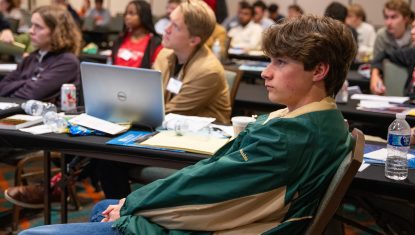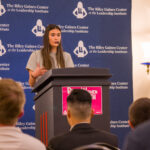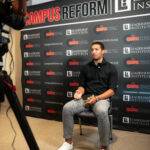John Kerry v. George W. Bush: Giving to 2004 Presidential Campaigns from Employees at U.S. News & World Report’s Top-Ranked National Universities
USN&WR’s 2004 School Rankings
| USN&WR’s 2004 School Rankings | Kerry/Bush Dollar Ratio | Kerry/Bush Dollar % | Number of Donations |
|---|---|---|---|
| Harvard | 31 to 1 | 97% to 3% | 406 to 13 |
| Princeton | 114 to 1 | 99% to 1% | 114 to 1 |
| Yale | 50 to 1 | 98% to 2% | 150 to 3 |
| Penn | 19 to 1 | 95% to 5% | 93 to 5 |
| Duke | 14 to 1 | 93% to 7% | 98 to 7 |
| MIT | 61 to 1 | 98% to 2% | 121 to 2 |
| Stanford | 9 to 1 | 90% to 10% | 257 to 28 |
| CIT | 11 to 1 | 92% to 8% | 22 to 2 |
| Columbia | 14 to 1 | 93% to 7% | 197 to 14 |
| Dartmouth | Infinity | 100% to 0% | 39 to 0 |
| Northwestern | 17 to 1 | 94% to 6% | 100 to 6 |
| Washington U. | 4 to 1 | 80% to 20% | 56 to 14 |
| Brown | 11 to 1 | 92% to 8% | 43 to 4 |
| Cornell | 20 to 1 | 95% to 5% | 142 to 7 |
| Johns Hopkins | 7 to 1 | 87% to 13% | 125 to 19 |
| Chicago | 5 to 1 | 84% to 16% | 77 to 15 |
| Rice | 4 to 1 | 78% to 22% | 21 to 6 |
| Notre Dame | 2 to 1 | 69% to 31% | 18 to 8 |
| Vanderbilt | 3 to 1 | 75% to 25% | 76 to 26 |
| Emory | 16 to 1 | 94% to 6% | 80 to 5 |
| Univ. of California | 25 to 1 | 96% to 4% | 694 to 28 |
| Carnegie Mellon | 18 to 1 | 95% to 5% | 55 to 3 |
| Michigan | 23 to 1 | 96% to 4% | 159 to 7 |
| UVA | 7 to 1 | 88% to 12% | 72 to 10 |
| Georgetown | 22 to 1 | 96% to 4% | 132 to 6 |
American colleges and universities are very different from the nation that surrounds them. The differences are especially profound when it comes to politics. The United States is closely divided between the two major parties, but no such division exists on any major college campus. Federal Election Commission records from 2004 show a wide disparity in donations to the two major presidential candidates from college and university employees.
Employees at Harvard University gave John Kerry $31 for every $1 they gave George W. Bush. At Duke University, the ratio stood at $14 to $1. At Princeton University, a $114 to $1 ratio prevails. The Kerry/Bush split in the number of donations is even more extreme. John Kerry received 257 donations of $200 or more from Stanford, while his opponent got just 28. At Northwestern, Kerry received 100 such contributions and Bush six. Georgetown University donations swung 132 to six in Kerry’s favor.
Deep Blue Campuses examines the political donations of employees at the top twenty-five national universities listed in U.S. News and World Report’s 2004 college issue. Specifically, this booklet compares donations in the 2004 election cycle to the two major presidential candidates, George W. Bush and John Kerry.
Although George Bush claimed a bare majority of votes in the actual election, John Kerry trounced him in donations received from colleges and universities. In fact, John Kerry received the lion’s share of donations from workers at all twenty-five schools featured in U.S. News and World Report’s annual survey. At one school (Dartmouth), Kerry posted an infinite advantage: FEC records show 39 donations to Kerry but not a single Dartmouth employee donating to George W. Bush’s campaign.
According to Federal Election Commission records, five of the top twenty institutions of all types from which donors made contributions to John Kerry’s campaign – the University of California, Harvard, Stanford, the University of Michigan, and Columbia – were universities. The UC system and Harvard actually gave more than Viacom, JP Morgan, CitiGroup, and other corporate behemoths. In contrast, no university ranked in George W. Bush’s top twenty contributors.
The buzzword on campus is diversity. The reality on campus is conformity.
Ward Churchill: Case Study
In the spring of 2005, Ward Churchill, a heretofore obscure professor of ethnic studies at the University of Colorado, became the subject of op-eds, cable news debates, blog posts, and angry talk-radio calls. Several schools, including Hamilton College, ignited controversy by inviting Churchill to speak. Churchill had penned a response to 9/11 entitled “Some People Push Back,” which characterized Osama bin Laden’s followers as acting with “patience and restraint” and compared the victims of 9/11 to Nazis.
America considers Ward Churchill a mental case. Academia considers Ward Churchill a scholar.
Churchill holds a master’s degree in communications from Sangamon State University yet somehow managed to get tenure at one of the nation’s more prestigious state universities. A committee of his peers even made him the chairman of an academic department. Outside the University of Colorado, universities officially invite him to address their students. Standing ovations interrupted Churchill’s post-controversy speeches at the Universities of Hawaii and Colorado, for instance, and overflow audiences packed the rooms. The Martin Luther King Jr. Collegium of Scholars at Morehouse College even inducted Churchill into its group.
The Churchill scandal illustrates the perils of campus conformity. The University of Colorado hires extremists such as Ward Churchill but excludes mainstream conservatives. When the Rocky Mountain News surveyed thirteen departments on the Boulder campus in 1997, they found a 31-1 Democrat/Republican party-registration imbalance among the faculty.
If a conservative relied on as underwhelming a resume as Ward Churchill and similarly exposed himself as a sloppy thinker in the way Churchill has, would he have received tenure, a department chair, and the support of the University of Colorado faculty? No.
Churchill’s radicalism, rather than his resume, landed him the job. Just as his politics were his qualifications, the politics of conservatives often disqualify them from academic positions.
Consequences of Groupthink
American college campuses are tiny blue islands engulfed in a giant red sea. The political alienation of the professoriate results in a tendency among academics to lash out at the surrounding society, to react immaturely to views contrary to their own, and to cultivate extremism among students. A more politically diverse faculty would alleviate these problems.
The controversy over Ward Churchill’s words coincided with a controversy over the words of a more famous academic. Harvard President Larry Summers’s speech exploring possible genetic differences in the cognitive abilities of the sexes sparked controversy on campus, whereas Churchill’s words sparked controversy off campus.
In response to the uproar over Churchill, hundreds of CU faculty purchased an ad in a Boulder newspaper expressing their support for their embattled colleague. In Summers’s case, the Harvard faculty of arts and sciences voted to call on Summers to resign.
Campus conformity makes freedom of speech a relative concept, subject to the political outlook of the speaker. If your words offend leftists, like Summers’s words did, it is deemed a firing offense. If your words offend everybody else, like Churchill’s words did, academics will defend you and label criticism “censorship.” On campus, what unfortunately matters is whose ox is being gored. This overwhelming political bias characterizes the faculties of all top colleges.
The campus is the place where speech should be the most free. The campus is the place where speech is the most restricted.
Offended by a politically incorrect campus newspaper, students in a women’s studies class at Rutgers fulfilled a required assignment to “construct a feminist action project” by collecting signatures demanding the university ban the publication. When the censorship campaign went nowhere, students took action into their own hands by confiscating and destroying an entire press-run of the paper in the fall of 2004.
Ball State University student Amanda Carpenter penned exposés on BSU faculty and its summer reading program in her campus publication, www.bsyou.net. In response, a BSU teaching assistant doctored images of her – superimposing her face over pornographic pictures – and posted them on a local message board.
Left-wing activists assaulted Ann Coulter, David Horowitz, Richard Perle, William Kristol, and Pat Buchanan as they spoke on campuses during the 2004-2005 school year.
Over 2004’s Thanksgiving weekend, Yale University thieves confiscated an entire press run of the Yale Free Press, a conservative student publication. The school’s Dean of Student Affairs refused to look into the matter, brushing off the student journalists. To have their complaint investigated, they had to individually contact each of the school’s eleven residential colleges, the Dean told them.
Why does a healthy exchange of ideas matter in an academic setting? The search for truth is the longstanding mission of higher education. When one side of the debate is silenced, finding the truth becomes more difficult. If institutions embraced intellectual diversity in the way they have embraced racial diversity they would be much more likely to foster debate and thus aid the search for truth.
Consequences of Groupthink, Part II
Ward Churchill merely defends terrorists. Other professors once were terrorists.
Bill Ayers bombed the Pentagon in 1972. Now he’s the Distinguished Professor of Education at the University of Illinois-Chicago.
Bernadine Dohrn, a terrorist who romanticized the Manson Family, reacted to the 1969 Helter Skelter slayings by remarking: “Dig it. First they killed those pigs, then they ate dinner in the same room with them, they even shoved a fork into a victim’s stomach! Wild!” Dohrn is now a professor at Northwestern University and gave the 2004 commencement address at Pitzer College.
Like Ayers and Dohrn, Mark Rudd helped lead the Weather Underground, which bombed banks, police stations, and university buildings in the 1970s. Today he teaches at a college in New Mexico.
However, what is taught is more important than who is teaching. While their lecture halls host scores of politicized courses such as “Women, Race, Gender, Sexuality” (Yale) and “Feminist Biblical Interpretation” (Harvard), Yale and Harvard prohibit the Reserve Officers Training Corps from using their classroom space.
A sample of ideologically-loaded courses elsewhere include the University of Michigan’s “How to Be Gay: Male Homosexuality and Initiation,” Amherst College’s “Taking Marx Seriously,” and the University of North Carolina’s “Environmental Advocacy.” Grading on an ideological curve, assigning activism for credit, and transforming lecterns into soap-boxes are among the pitfalls of a hyper-politicized faculty.
Campus Bias
For years, the left dismissed such anecdotes as cherry-picked examples that distort the reality of the campuses as repositories of debate, intellectual diversity, and free speech. In response, conservatives began to undertake empirical surveys demonstrating the political imbalance on college campuses.
Numerous studies have demonstrated just how politically slanted the campuses are. The findings of Deep Blue Campuses are consistent with the existing body of data that shows that those entrusted with imparting knowledge to the rising generation are outside of the mainstream.










